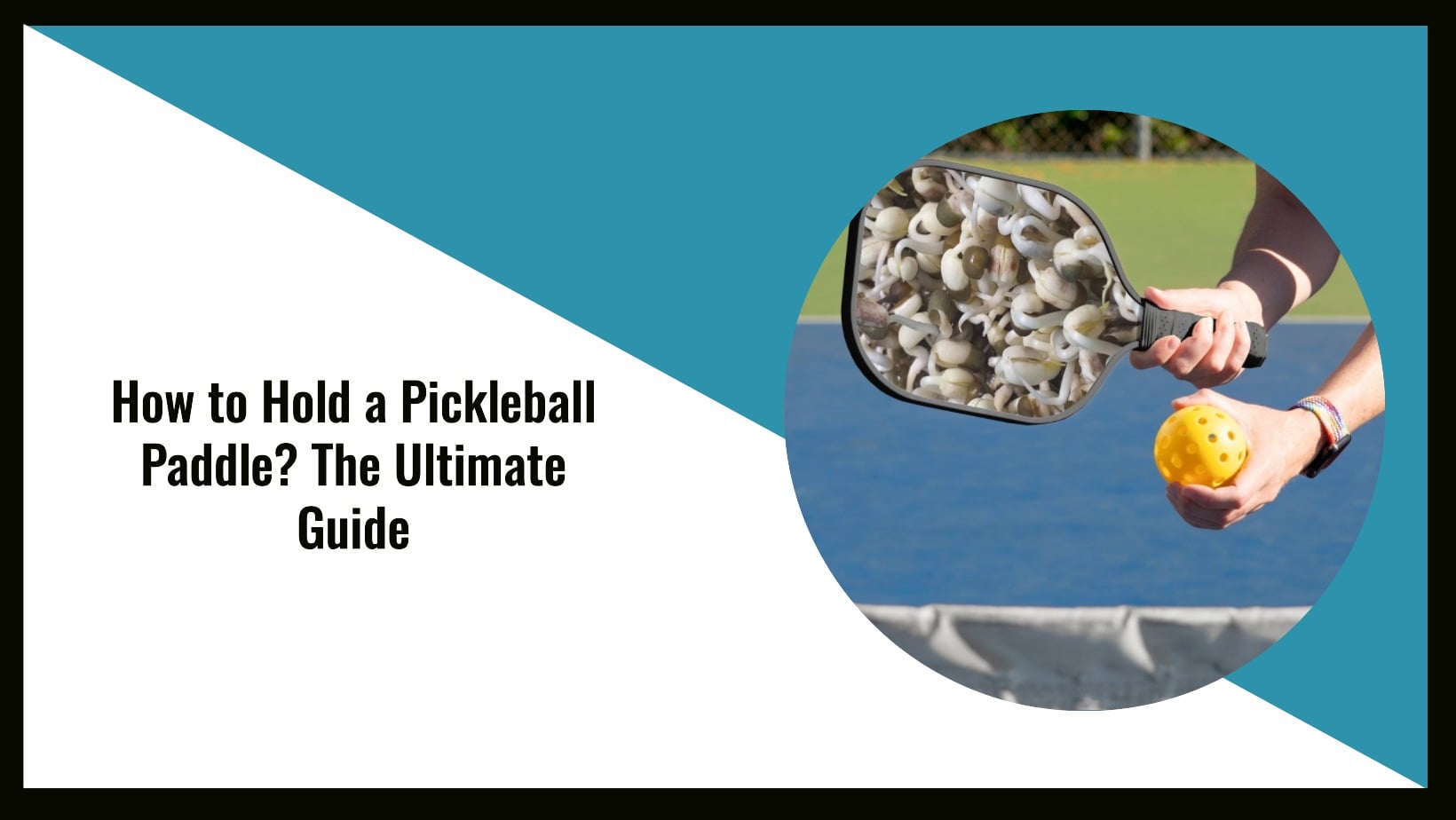Looking for a thrilling and exciting way to stay fit and active? Look no further than pickleball! This high-energy sport combines the best elements of tennis, badminton, and ping pong, making it a fun and challenging game for players of all ages and skill levels.
But, before you hit the court and start racking up points, it’s essential to master the fundamentals of the game, including how to hold your pickleball paddle. Don’t worry, though – with the right grip, you’ll be smashing serves and hitting cross-court shots like a seasoned pro in no time.
So, get ready to up your game with this in-depth guide on how to hold a pickleball paddle, complete with tips, tricks, and expert advice to take your skills to the next level. Let’s get started!
The Basics of Pickleball Paddle
Pickleball paddles are bigger and sturdier than table tennis paddles. It is composed of wood or composite materials such as graphite, fiberglass, or carbon fiber and has a flat surface. A thin coating of vinyl or plastic is frequently applied to the surface to create texture and color.
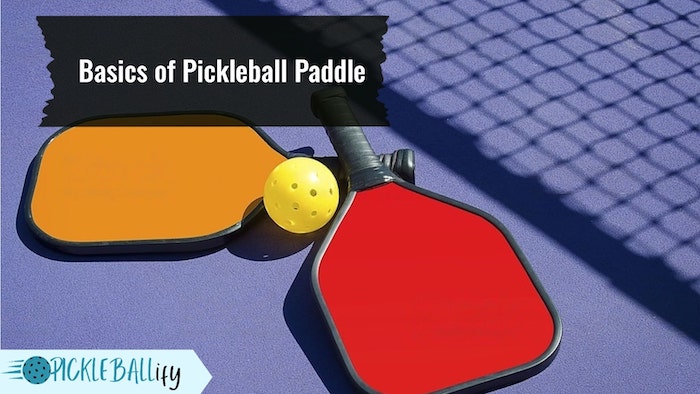
The paddle’s form can range from round to square to elongated. The USA Pickleball Association (USAPA) governs the size of the paddle, which must be at least 24 inches long and 8 inches broad. Depending on the material and design, the weight of the paddle can range from 6 to 14 ounces.
You can check whether you have USA Pickleball Association (USAPA) approved pickleball paddle or not on USAPickleball.
The paddle’s material and weight have an impact on its feel, durability, and performance. Wood paddles are often heavier, less expensive, and more durable than composite paddles. They are, however, less responsive, less comfortable, and less forceful than composite paddles.
Composite paddles are lighter, more costly, and more prone to wear and tear than wood paddles. They are, nevertheless, more responsive, comfortable, and forceful than wood paddles. They also have more variation in terms of form, size, color, and design.
Different Pickleball Paddle Grips
Pickleball paddle grips are the way you hold your paddle handle when playing pickleball. The grip can affect your comfort, control, power, and spin on the court. There are three main types of grips that you can use:
- The continental grip,
- The eastern grip, and
- The western grip.
Each grip has its own advantages and disadvantages, depending on your skill level and playing style. Here is a brief overview of each grip and how to use it:
1) The Continental Grip
The continental grip is the most versatile and common grip in pickleball. It allows you to switch easily between forehand and backhand strokes, as well as volleys and serves.
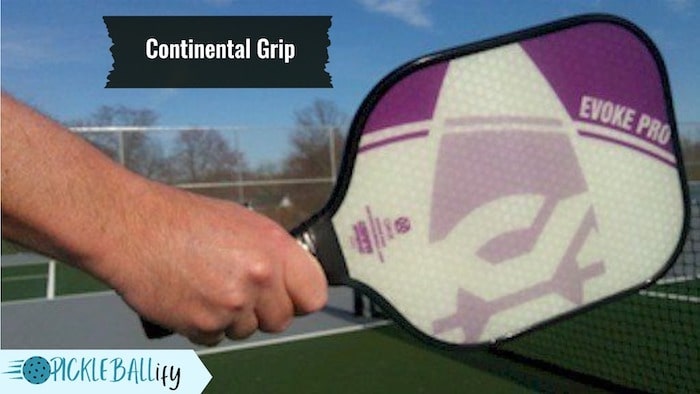
To use this grip, hold your paddle like you are shaking hands with it, with your thumb and index finger forming a V shape on the top bevel of the handle.
Your knuckle of your index finger should be on the 2 o’clock position if you are right-handed, or in the 10 o’clock position if you are left-handed. The continental grip is good for players who play equally with both sides of their paddle and want a balance of power and control.
2) The Eastern Grip
The eastern grip is more suitable for players who prefer to hit with more topspin and power, especially on their forehand side.
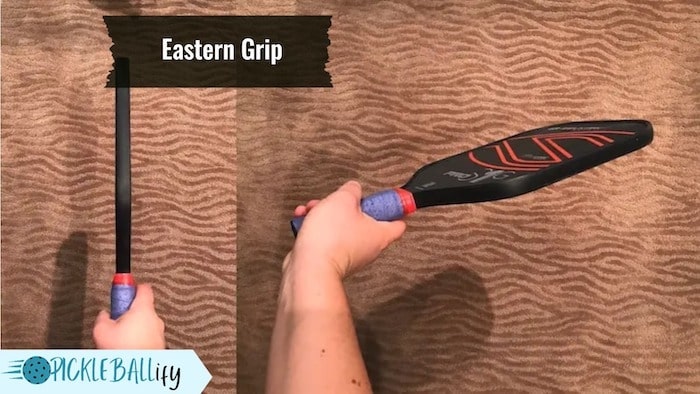
To use this grip, rotate your hand slightly clockwise (if you are right-handed) or counterclockwise (if you are left-handed) from the continental grip, so that the knuckle of your index finger is on the 3 o’clock position (right-handed) or on the 9 o’clock position (left-handed).
Your thumb should be on the side of the handle, rather than on top. The eastern grip gives you more leverage on the paddle face and allows you to hit with more wrist action.
3) The Western Grip
The Western grip is more suitable for players who like to hit with more slice and control, especially on their backhand side.

To use this grip, rotate your hand further clockwise (if you are right-handed) or counterclockwise (if you are left-handed) from the eastern grip, so that the knuckle of your index finger is on the 4 o’clock position (right-handed) or on the 8 o’clock position (left-handed).
Your thumb should be underneath the handle, rather than on the side. The western grip gives you more angle on the paddle face and allows you to hit with more spin.
How to Hold a Pickleball Paddle
How you hold your paddle can affect your power, control, spin, accuracy, and efficiency on the court. Here are some tips on how to hold a pickleball paddle correctly:
The Proper Grip
The grip refers to how your fingers are positioned around the paddle’s handle. The continental grip, the eastern grip, and the western grip are the 3 main grip styles that are available. Depending on your level of expertise and playing style, each grip offers pros and cons.
The most popular and adaptable grip is the continental grip because it makes switching between forehand and backhand strokes simple. The eastern grip, which provides you greater leverage on the paddle face, is better suited for those who love to hit with more topspin and power.
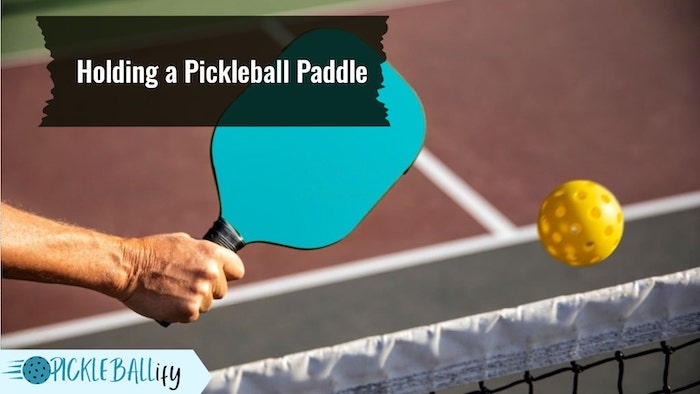
The western grip, which provides a larger angle on the paddle face, is ideal for people who prefer to strike with more slice and control. Test out several grips to find which one feels the most natural and comfortable to you. This will assist you in determining your preferred grip.
The Proper Angle
The angle refers to how much your paddle face is inclined towards the ball. The angle can affect the direction, height, speed, and spin of your shots. Angles are classified into three types: flat, open, and closed.
- A flat angle produces a straight and low shot, which implies your paddle face is parallel to the ground.
- A high and deep shot is created when your paddle face is at an open angle that is somewhat upwardly inclined.
- A closed angle means that your paddle’s face is somewhat angled downward, resulting in a low and short shot.
Practise shooting from various angles to see which one gives you the most consistency and accuracy. This will assist you in determining your perfect angle.
The Proper Position
The position of your paddle with regard to your body and the ball is referred to as the position. Your posture can affect your balance, timing, reach, and responsiveness on the court. In general, the three primary positions you may use are high, low, and neutral.
- You may improve your power and coverage by holding your paddle high, but this may affect your control and speed.
- When you hold your paddle in a low posture, it is below your waist level, which promotes control and speed but may compromise power and coverage.
- By holding your paddle at chest level in the neutral position, you may balance power, control, speed, and coverage.
Find your best position by practicing different shots from various stances and observing which one makes you feel most at ease and confident.
How to Improve Your Pickleball Paddle Skills
Holding a pickleball paddle correctly is merely the first step towards becoming a better player. You should also practise and strategize to better your skills.
Here are some tips and tricks for better control, power, and spin on the court:
For Better Control
The ability to position the ball on the court where you want is referred to as control. To improve your control, swing the club in a smooth motion. Swinging too aggressively or too softly may result in errors or bad shots.
While striking the ball, aim towards the middle of the paddle face for improved stability and accuracy. Change the velocity, angles, and spins of your shots to confound and throw off your opponents.
For example, you may smash a gentle drop shot to lure your opponents to the net, followed by a strong lob to push them back to the baseline.
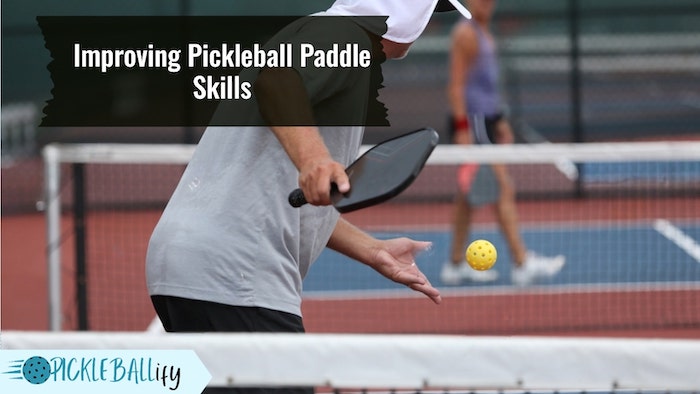
For Better Power
The ability to strike the ball rapidly and firmly is referred to as power. To boost your power, concentrate on building momentum and utilising your complete body. Avoid using only one arm or wrist to avoid injury or weariness.
Aim to smash the ball as high and in front of your body as possible to maximise its impact and distance. Finally, hit the ball with a flat or slightly closed angle to generate a lower and faster stroke.
For Better Spin
Spin is the ability to make the ball to circle in different directions. To improve your spin, instead of striking the ball flat, focus on contacting it with the edge of your paddle face. Furthermore, depending on the type of spin you want to create, try striking the ball with an open or closed angle.
For example, you can hit the ball with an open angle and a side-to-side motion to create a topspin, which makes the ball bounce higher and faster. Or you can hit the ball with a closed angle and a downward motion to create a backspin, which makes the ball bounce lower and slower.
FAQs
Yes, you can switch your grip during a game depending on the type of shot you want to make. For example, you might switch to an Eastern grip for a powerful forehand drive, and then switch to a Continental grip for a soft drop shot.
No, the grip you use will depend on the type of shot you want to make. For example, a Continental grip is suitable for volleys and serves, while an Eastern grip is more suited for groundstrokes.
To prevent blisters, you can use an overgrip to provide a more cushioned and comfortable grip. You can also try wearing gloves or wrapping your hand in athletic tape.
It’s not necessary to switch your grip depending on which side of the court you’re on, but some players may find it helpful to switch to an Eastern grip when hitting forehands on the backhand side of the court.
Yes, you can adjust your grip during a rally, but it’s important to do so quickly and smoothly to avoid losing control of the ball. It’s also important to practice switching your grip quickly so that you can do it seamlessly during a game.
Final Thoughts
In conclusion, mastering how to hold a pickleball paddle is a crucial part of improving your game on the court. By choosing the right grip and holding the paddle correctly, you can increase your control, power, and accuracy in your shots.
Experimenting with different grip styles and paddle weights can help you find the perfect fit for your playing style, while regular warm-up exercises can help you prevent injuries and improve your grip strength. With these tips and tricks in mind, you’re ready to hit the court and take your pickleball skills to the next level.
So, grab your paddle, find a partner, and get ready to serve up some fun!

